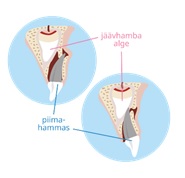Traumatic dental injury. General information
TRAUMATIC DENTAL INJURY
Dental trauma is an injury to the tooth or surrounding structures which may lead to tooth crown or root fracture, damage to the bone and soft tissues surrounding teeth, tooth luxation or teeth dislodging from the jaw.
RISK FACTORS AND CAUSES
- not wearing protective mouth guards during contact sports increases risks;
- not using protective gear (helmet) while driving a scooter, skateboard, bicycle or hoverboard;
- chewing on solid objects (e.g. ice cubes, pencil);
- opening beverage cans, bottles and food packages with teeth;
- diseases of surrounding bone and tissues of the teeth (e.g. periodontitis);
- tooth decay;
- abnormal dentition;
- tongue and lip studs;
- intentional injuries (blows) or unintentional injuries (falling, sliding e.g. ladder, trampoline, etc.);
FOLLOW-UP VISITS
It is important to comply the recall intervals assigned by the dentist to monitor healing of the area and assess the need for the further treatment (see the patient information leaflet for root canal treatment). The splint should be removed within 2-4 weeks after the trauma. Assigned recall intervals are: 2 weeks, 1 month, 2 months, 3 months, 6 months, one year after the trauma, thereafter once in a year for the following 5 years.
Kindly avoid sports and psysical exercise following the trauma in the mouth.
PROGNOSIS AND POSSIBLE COMPLICATIONS AFTER TRAUMATIC DENTAL INJURY
Several complications may arise after dental trauma. It is difficult to determine the prognosis of injury and probability of the long term survival for every traumatically injured tooth.
Most common complications of dental injuries are:
- toothache;
- tooth nerve necrosis (non-vital tooth) and root infection;
- mobile tooth;
- discoloration of tooth;
- tooth luxation;
- fusion of the inner or outer surface of tooth root, outer surface replacement with bone;
- halted tooth development;
- complete loss of tooth;
- deciduous tooth trauma affecting permanent tooth developing inside the bone:
- permanent teeth eruption disorders (tooth does not erupt correctly);permanent teeth development is halted (tooth does not develop completely);
- enamel damage of the permanent teeth (crown appears different from the neighbouring tooth).

Alterations on permanent dentition may occur following dental trauma to primary teeth. The treatment method of injury to primary teeth is selected based on the age of the child. The child’s coopetation to receive treatment is an important factor that affects treatment plan and process.
Tooth ankylosis in childhood contributes to jaw developmental delay in the trauma area and orthodontic/surgical treatment is required later.
PREVENTING DENTAL TRAUMAS
Dental traumas are common among children and adolescents but occur most often in children 7-10 years old due to the elasticity of their jaw bones.
- Avoid using push along walking aids, if a child is unable to walk independently.
- Teach the child to use protective gear (helmet) while driving a bicycle, scooter, skateboard, roller skates or other mobile equipment. The parent serves as an important role model.
- Explain to the child the importance of protecting the head. During the play time hard objects should not be in the vicinity of the head area, especially teeth. Explain that pushing playmates is not allowed.
- Wear the protective mouth guards available at sports stores or custom-fit manufactured at the dental office whilst playing sports; Change them according to the growth of the jaws.
IMMEDIATE ACTION FOR TRAUMATIC DENTAL INJURY
- Stay calm. If you are taking care of injured person, comfort him or her.
- Carefully clean the wounds with water and determine the exact extent of the injury.
- Ensure that the trauma is not more extensive. Call an ambulance if necessary.
- Find the lost tooth or part of it. Make sure to hold the tooth by the crown (wider part) only. If the tooth is dirty, rinse it carefully in cold running water for a short time.
- If a permanent tooth has fallen out or luxated, try to place the tooth back to its original position.
- Note! Never try to put a baby (deciduous or primary) tooth back in the gum if it is knocked out. This can damage the developing permanent tooth bud.
- If you can’t put the tooth or broken tooth part back into the mouth, store the fragment in a saline solution, pasteurised milk, or injured person’s saliva. Do not let the tooth become dry.
- See a dentist urgently as an emergency patient.
- Comply the recall intervals assigned by the dentist.
- Eat soft foods in the next two weeks and avoid biting and chewing on hard substances. It is recommended to chew with the opposite side of the mouth.
- Maintain an excellent oral hygiene: brush teeth twice daily with a soft toothbrush and fluoride-containing toothpaste; brushing healthy teeth with floss and a toothbrush. Bad oral hygiene leads to gingivitis and worsens the prognosis of treatment. During the first week it is recommended to perform dental hygiene procedures after each meal.
- Don’t touch the traumatised area with your tongue or fingers.
- Rinse your mouth with chlorhexidine mouthwash twice a day for 1-2 weeks.
- Apply 0,2% chlorhexidine gel on the wound with a clean cotton or gauze pad 2-3 times a day.
- Antibacterial treatment is indicated for tooth avulsion (complete removal of the tooth from the mouth) and soft tissue injuries.
- Tetanus immunization should be updated if necessary after tooth avulsion.
In case your condition worsens or you have any question, please contact your dentist or healthcare facility.
Authors: Dr Valeria Hameury, Dr Teele Paltsar, Dr Marjo Sinijärv and Anna Firsova
2023